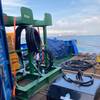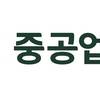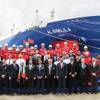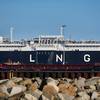The EU is working toward creating a general standard for protective suits in the high-pressure water jet industry. On December 12, 2002, experts representing manufacturers and test houses from France, Germany, Sweden, and Belgium, as well an observer from the United States met in Brussels, Belgium. The host of the meeting was the Notified Body Centexbel, coordinated by Fred Foubert. The group worked towards developing a standard method of testing that could be used throughout Europe to evaluate Personal Protection Equipment (PPE) used by operators in the water jet industry. There is currently no uniform standard of protection levels for the water jet industry. Three tiers of protection were discussed using energy criteria.
An alternative to traditional sandblasting, water jetting is used for removal of surface coatings, cleaning and cutting in the marine, chemical, and offshore industries. Operators use handheld guns or lances at pressures as high as 2800 bar. By using water, contaminants can be filtered out, reducing the cost of hazardous waste disposal, as opposed to contaminated sand, which can be expensive and ecologically unsound. Although water jetting is highly efficient for demolition and resurfacing, such high flow rates pose a substantial risk to operators. Water jetting accident rates and severity are exceedingly high for commercial operations. In addition to fatalities, injuries sustained can result in amputation or severe infection due to the amount of contaminated water being carried into soft tissue. Despite the high risk of injury, operators do not universally wear PPE. Last May, the Health and Safety Executive (HSE) of the United Kingdom announced the mandatory requirement of PPE in all Ultra High Pressure water jetting applications. Other countries are reviewing their standards in light of the English approach to water jetting safety.
(more)
There are currently two manufacturers of PPE with CE marking: US-based TurtleSkin WaterArmor and Swedish-based TST. At present, there is no uniform test standard to use in certification of water jetting gear. The meeting this past December at Centexbel was a step in that direction. The group of international representatives worked towards creating a standardized testing protocol that realistically simulates the various types of water jetting conditions that operators face.
In order to achieve an accurate, reproducible test method, the task group evaluated a complete set of testing variables including nozzle type, swipe speed, water pressure, flow, and back thrust or recoil. The group also discussed the size of the sample, the method in which the sample will be held down, the type of human tissue simulant to be used as backing, and the standoff distance between nozzle and sample. The backing must be solid enough not to fluctuate under the pressure of the jet stream, but soft enough to simulate human flesh. In addition to a membrane to witness backside trauma, two types of foam backing were considered: one to simulate the soft tissue of a torso and one to test the harder tissue of a shin or thigh. Nozzle types were discussed at length, determining a highly efficient nozzle is extremely important to the integrity of the test. The standoff between the jet nozzle and sample will be set at a specific distance and the water jet stream will scan across the sample at a fixed rate with a pressure and flow strong enough to reproduce the high recoil or thrust that operators encounter. The task group's work in setting a uniform test method will help water jets operators better understand the level of protection provided by their PPE and establish an universal standard of personal safety.
Featured videos

Unlock Onboard Data Efficiencies

Tracking Foreign Vessels Working in the U.S. Jones Act Market

Inmarsat Enhances Service to Drive Digitalization
Subscribe for
Maritime Reporter E-News
Maritime Reporter E-News is the maritime industry's largest circulation and most authoritative ENews Service, delivered to your Email five times per week









